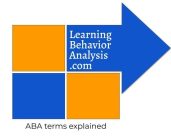A-5: Describe and define the dimensions of applied behavior analysis (Baer, Wolf, & Risley, 1968) ©
Want this as a downloadable PDF? Click here!
Target Terms: Generality, Effective, Technological, Applied, Conceptually Systematic, Analytic, Behavioral

Generality
Definition: Behavior change that lasts over time, appears in environments other than the environment which it was taught and/or spreads to other behaviors not targeted by the intervention.
Example in everyday context: As a child, you learned how to use the microwave (and the toilet, and the sink, and the doorknob, and the remote control…). Throughout the years, you have used different microwaves (and other items) in various locations without being taught again. This represents generality, since you were not explicitly taught how to use every microwave you have ever encountered.
Example in clinical context: An RBT® at a residential treatment facility is implementing an intensive toilet training procedure with a client. The RBT teaches the child how to request “toilet” and using the bathroom at the facility. The client masters using the restroom in this setting. When the client is at school, they demonstrate the same behavior of requesting to use the toilet and successfully voiding without being taught at school. Data demonstrate that the client is 100% successful in requesting and using the toilet even six months after toilet training. This behavior change has generality because it has lasted over a long amount of time and is reported to occur in different environments without explicit instruction.
Example in supervision/consultation context: You teach a paraprofessional how to run manding sessions with Client A. Without further instruction, the paraprofessional then demonstrates the ability to run manding sessions with Client B. This behavior change demonstrates generality because the paraprofessional was able to perform the behavior outside of the original learning parameters.
Why it matters: Generality is an important outcome of behavior programs because it demonstrates additional dividends in terms of behavioral improvements. The more generality a behavior program has the more successful a person can be across environments and over time. A great deal of our day-to-day success relies on our ability to apply skills we have learned in related, but different, circumstances.
Effective
Definition: Behavior that changes in a practical manner that result in clinical or social significance.
Example in clinical context: A behavior analyst is researching an appropriate intervention designed to target tolerance for non-preferred activities for a particular learner. Two interventions are trialed with the learner. Both of them are acceptable to the client and caregivers, and realistic given their needs. Intervention A was found to be increase tolerance by 30% over baseline and Intervention B was found to increase tolerance by 45% over baseline. The behavior analyst concludes that Intervention B should be implemented, and continues to monitor the client’s behavior data related to their tolerance goals.
Example in supervision/consultation context: You begin supervising a new trainee, and decide to implement the same supervision curriculum as you have been using with former trainees. In the past, this curriculum has yielded 100% pass rates on the board exam, and your trainees in the past quickly demonstrated skill increases. However, after two weeks, you review your new trainee’s progress and find that their skills have not significantly changed. Guided by ABA’s commitment to being effective, you must investigate the problem further and make changes to ensure that your supervision services are effective.
Why it matters: Behaviors targeted for intervention must be meaningful, significant and promote long term, positive changes in the participant. The goal is to improve the quality of life of individuals across settings. The great emphasis placed on effective treatment for each individual client is sometimes at odds with the philosophies of other professional disciplines with whom we collaborate.
Technological
Definition: All procedures of an intervention, data and results of an experiment or study are clearly outlined in detail so they can be understood, replicated and implemented by anyone with the prerequisite skills.
Example in everyday context: You find a recipe for a cake on the internet. The recipe lists the ingredients and how to use them to make a cake. This recipe is technological because it includes the information needed to complete the task.
Example in clinical context: You have conducted a research study with several children who engage in self-injurious behavior and find a combination of a reinforcement and punishment procedure that worked well with all of the children in the study. You prepare your procedure, data, results and analysis in a professional paper to share with colleagues. After your colleagues review your research, they report to you that it was so well written they could implement the same procedure in their own practice. Your research paper demonstrates the dimension of technology, as it included all elements that were required to complete your study as well as provide sufficient detail in terms of analysis and results.
Example in supervision context: A behavioral consultant is training a newly hired paraprofessional on a student’s behavior plan. The behavioral consultant outlines each step with sufficient detail and clarity for the paraprofessional. The paraprofessional acts out the implementation of the behavior plan without making any mistakes. This demonstrates that the behavioral consultant wrote the plan out technologically since it was clearly understood and performed by another person.
Why it matters: Behavior changes methods will not be effective if practitioners cannot replicate them. Therefore, descriptions of procedures must be teachable and easy to understand by others so they can be implemented with fidelity.
Applied
Definition: The commitment to supporting improvements in people’s behaviors to enhance their quality of life.
Example in clinical context: A behavior analyst “inherits” a learning plan for a high school student with Autism. The plan involves learning goals such as sorting pictures, copying sight words, and labeling colors and numbers. None of these skills are meaningful given the client’s characteristics, so you collaborate with others and change the plan to include skills that will make a difference in the person’s life, such as manding for wants and needs, self care, community safety, and leisure skills.
Example in supervision context: You are a new consultant in a classroom for children with challenging behaviors. You make sure to assess the skills and needs of the teacher, and then provide skill-building sessions for the teacher, based on what they need to be able to do in order to do their job more effectively.
Why it matters: The applied dimension of applied behavior analysis must target to improve the social, academic, language, daily living skills and day to day experiences of the client and other stakeholders. In other words, we should often ask, “Is this meaningful?”
Conceptually Systematic
Definition: All procedures used in practice should be related to the basic behavioral principles of behavior analysis from which they were derived.
Example in clinical context: A behavior analyst is reviewing their client’s treatment plan with the parents. When describing how the behavior analyst will teach replacement behaviors for escape maintained aggression, the parent suggests, “Why can’t we redirect them with deep pressure and using a weighted blanket?” The behavior analyst kindly explains that this would be entirely inconsistent with the nature of the problem, and would therefore be unlikely to help the family reach their goals. Therefore, the suggested strategies cannot be written into the plan.
Example in supervision context: A teacher tells you that their 10-year-old client “Isn’t repeating many words yet, because they’re not there developmentally.” You suggest that a closer look at the specifics of the problem, rather than assuming that the skill will eventually happen in time, would be appropriate. After your coaching, the teacher uses shaping procedures to systematically enhance the student’s echoic repertoire. This teacher is now demonstrating the use of conceptual systems in their teaching of echoic behavior.
Why it matters: Relating specific behavioral procedures to basic principles enables the practitioner or researcher to derive other similar procedures from the same principles. These systems of behavioral procedures become an integrated discipline rather than a collection of “behavioral tricks”, with the ability to lend themselves to systematic expansion.
Analytic
Definition: The demonstration of a reliable functional relationship between environmental changes (assessment/intervention) and target behavior changes. Most basically, being analytical means making data-driven decisions.
Example in clinical context: A functional analysis is conducted with a client who engages in hitting others. The results demonstrate that the behavior of hitting others occurs almost exclusively when a demand is placed on the client, and that hitting increased over time when staff removed demands contingent on hitting. Results of a subsequent treatment evaluation indicate a functional relationship between hitting others and the removal of demands.
Why it matters: In order to do our work, we need to know if there is a reliable functional relationship between our interventions and the client’s behavior change (skill acquisition or behavior reduction).
Behavioral
Definition: Observable and measurable behavior should be the focus of our work.
Example in clinical context: A behavioral consultant takes frequency data on a client who engages in several types of appropriate social interactions (greetings, responding to questions, nodding when others are speaking, saying goodbye before leaving, etc). Each type of behavior has an operational definition. The consultant records the data as they are observing the client by following the operational definitions.
Example in supervision/consultation context: You assign your supervisee to collect data on a student’s out of seat behavior during instructional time. The supervisee comes back and reports they did not observe the target behavior, but instead recorded every instance the student appeared to be daydreaming. You explain to your supervisee that “daydreaming” means different things to different people, and is not an observable or measurable behavior. You encourage your supervisee to continue to observe the student and to collect data on the target behavior.
Why it matters: This dimension requires behavior analysts to be precise and objective in their measurements of the target behavior. We cannot do our work unless we know exactly what we are working on!
